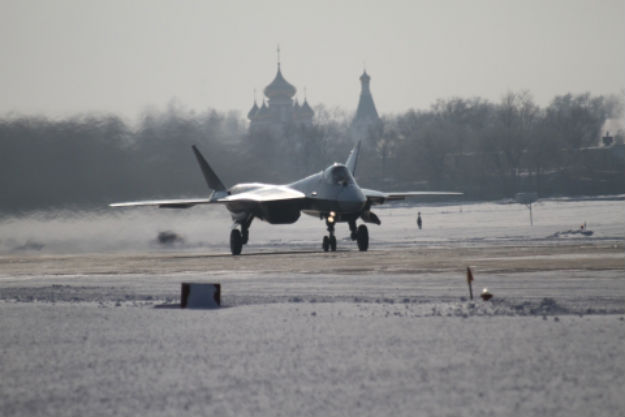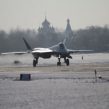
Russian Defense Industry Creaks Under Rearmament Program
Publication: Eurasia Daily Monitor Volume: 11 Issue: 133
By:

Russia’s growing international isolation over its policy toward Ukraine and reaction to the downing of Malaysian Airlines Flight MH17 may prove to be an unexpected test for the highly ambitious plan to rearm the Russian military to 70 percent new or modern equipment by 2020. While many defense specialists questioned whether the domestic capacity exists to reach such targets, international sanctions on high-technology products, a possible stiffening of the sanctions regime, and the breach in military-technical cooperation with Ukraine all add pressure to revise this aspiration. However, these additional pressures and setbacks may simply serve to further expose underlying issues within the Russian defense industry, though the interim response has so far been limited to military expos and President Vladimir Putin reasserting that “70 percent” remains on-track (Aex.ru, July 18; Nezavisimoye Voyennoye Obozreniye, June 27).
Beyond the sporadic and piecemeal arrival of new or modern weapons and equipment in Russia’s Armed Forces, the bulk of the focus in the 2014 State Defense Order (GOZ) remains, unsurprisingly, pre-occupied by modernizing the Strategic Rocket Forces (Raketnye Voyska Strategicheskogo Naznacheniya—RVSN). A recent meeting of the RVSN military council considered the implementation of the GOZ 2014. For the RVSN, this falls broadly into two key areas: research and development (R&D) and the purchase of new weapons and equipment. R&D is mainly focused on creating advanced missile systems with stationary and mobile options, developing new combat equipment to overcome missile defense, and modernizing Russian command, control and communications. High priority is also assigned to developing the RS-24 Yars Intercontinental Ballistic Missile (ICBM) with moveable and stationary basing, procuring training facilities and modernizing technical instruments (I-mash.ru, July 17).
Despite Putin calling on the defense industry to honor the 70 percent target by 2020, and although high priority elements such as modernizing the RVSN are proceeding like a state juggernaut, there are more sober assessments of the low capacity within the defense industry to deliver. Some critics, for example, question as to whether Russia can really introduce Western-style “life cycle contracts,” which ensure value for money and ongoing maintenance of the procured products. In Russia, such an approach is doomed to fail before its introduction due to the primacy of commercial over public interests, the absence of effective enforcement mechanisms for contracting parties to fulfil their obligations, the persistence of departmental disconnects in the process, low executive discipline, and the weak financial and technical equipment of many manufacturers. All these shortcomings result in the defense ministry being disadvantaged in the pursuit of modernization (Nezavisimoye Voyennoye Obozreniye, June 27).
In August 2014, the Russian Military-Industrial Commission will host a conference on defense modernization, on the theme of how the defense industry may cope with a harsher Western sanctions regime. Many Russian defense specialists are considering how the country can avoid a downturn in military production at a critical time. A number of related issues are likely to be discussed: ranging from weapons types and upgrades to the risks of depending on foreign purchases. Chief among these pressing issues must surely be the low condition of Russian R&D. According to Yury Koptev, the chairman of the Scientific and Technical Council of Rostekhnologii, R&D is currently almost “non-existent.” Other Russian experts argue that R&D should be raised in this period to 40 percent, and say that it currently languishes at around “10 to 15 percent,” which by itself will severely restrict the success of Russia’s rearmament program to 2020 (Voyenno Promyshlennyy Kuryer, July 16).
Andrei Pronko, Chief Adviser to the Security Council, readily admits that the crisis in Ukraine is likely to impact on the ambitions of the Russian rearmament program. Pronko sees the pre-crisis interconnection between the Russian and Ukrainian defense industries as a serious issue. Other Russian defense specialists criticize the domestic industry for its lack of creativity, and call for more room for profits, yet fail to offer solutions. Alexander Larionov, the Deputy Chief Designer of MKB Vympel, highlights the inherent tendency in the defense industry to simply “copy” the experience of foreign companies. Larionov estimates that up to “50 percent” of the microelectronics used in modern information systems in the Russian military are imported, and worse still, what is “created” at the design stage is merely a replication of foreign approaches. Since this takes a cycle of six to eight years to introduce, the military is consequently always trapped in receiving “someone else’s technology” from the past (Voyenno Promyshlennyy Kuryer, July 16).
Alexander Rakhmanov, Deputy General Designer of RTI, argues that the rearmament program to 2020 will achieve only limited success due to being hampered by issues of pricing, a weak regulatory framework, and the harmonization and standardization between the defense ministry and other agencies. Rakhmanov calls for a reassessment of the priorities in defense modernization, while noting additional flaws in the system, stating that “there is no comprehensive data or methods or models that would allow it to work.” He portrays this “system,” as “unable to fully ensure the balanced development of rational decisions regarding weapons systems.” Rakhmanov also questions the over-reliance on nuclear weapons and designing methods of combating the theoretical threat posed by foreign, high-tech airborne weapons systems, at the expense of assessing the nature of more likely threats and procuring suitable systems to counter them (Voyenno Promyshlennyy Kuryer, July 16).
Sergei Grinyaev, the CEO of the Moscow-based Center for Strategic Studies and Analysis, notes the importance of building the lessons of combat experience into the state armaments program, especially in relation to the 2008 Russia-Georgia War. But he wants this to be done carefully. While many flaws in rearmament strategy were exposed during that conflict, the T-72 tank has performed well in Syria. Grinyaev, therefore, would recommend an approach to military modernization that avoids too much focus on the “new,” and cautioning against “blindly” purchasing systems from abroad (Voyenno Promyshlennyy Kuryer, July 16). However, he pays scant attention to the use of dated weaponry in eastern Ukraine to destabilize the country.
In all of these public discussions, there is an awareness that the problems facing Russia’s domestic defense industry were already deep prior to the Ukraine crisis. The Moscow conference in August, which will further examine the impact of international sanctions on Russia, may well indicate growing concern about how to achieve the targets linked to modernizing the Armed Forces. But it could equally address how to cut the limited cloth to suit the shifting strategic balance (Voyenno Promyshlennyy Kuryer, July 16; Nezavisimoye Voyennoye Obozreniye, June 27).




